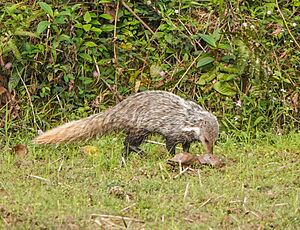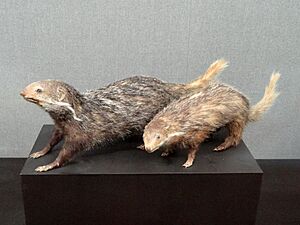Crab-eating mongoose facts for kids
Quick facts for kids Crab-eating mongoose |
|
|---|---|
 |
|
| Conservation status | |
| Scientific classification | |
| Genus: |
Urva
|
| Species: |
urva
|
| Subspecies | |
|
|
 |
|
| Distribution of the crab-eating mongoose | |
| Synonyms | |
|
Gulo urva |
|
The crab-eating mongoose (its scientific name is Urva urva) is a type of mongoose. You can find these cool animals in places like the north-eastern Indian subcontinent and Southeast Asia. They also live in southern China and Taiwan. Good news! They are currently listed as "Least Concern" by the IUCN Red List. This means they are not in immediate danger.
Contents
What's in a Name?
Every animal has a scientific name, which is like its unique code. The crab-eating mongoose was first named Gulo urva by Brian Houghton Hodgson in 1836. He found the first example of this animal in central Nepal. Later, scientists thought it belonged to a group called Herpestes. But now, all Asian mongooses are believed to be part of the Urva group. The crab-eating mongoose is the main species in this Urva group.
What Do They Look Like?
The crab-eating mongoose has grey fur on its sides. Its neck, chest, belly, and legs are a dusky brown color. A wide white stripe runs along the sides of its neck. This stripe goes from its cheeks all the way to its shoulder.
You might notice white specks on the top of its head. Its chin is white, and its throat is grey. This mongoose has yellow eyes and short, rounded ears. It even has webs between its toes, which helps it in water! From head to body, they are about 48 to 56 centimeters (19 to 22 inches) long. Their bushy tail adds another 28 to 34 centimeters (11 to 13 inches). These mongooses usually weigh between 1.1 and 2.5 kilograms (2.4 to 5.5 pounds).
Where Do They Live?
The crab-eating mongoose lives in many parts of Asia. You can find them in northeastern India, northern Myanmar, Thailand, and Peninsular Malaysia. They also live in Laos, Cambodia, and Vietnam. They are quite rare in Bangladesh. These animals can live in many different places. They are found from sea level up to about 1,800 meters (5,900 feet) high.
In Nepal, they like to live in forests that stay green all year. They also live in moist forests where trees lose their leaves. Sometimes, they are even seen on farms close to where people live. In India, they have been seen in Assam and Arunachal Pradesh. In China, they were found in forests on limestone hills.
What Do They Do and Eat?
Crab-eating mongooses are usually active in the mornings and evenings. They have been seen in small groups, sometimes with up to four individuals. They are known to be good swimmers. They often hunt for food along the edges of streams and near water.
Even though they are called "crab-eating" mongooses, crabs are not the only thing they eat! Their diet is very varied. They will eat almost anything they can catch. This includes fish, snails, frogs, and small rodents like mice. They also eat birds, reptiles, and many different kinds of insects.
How Are They Protected?
The crab-eating mongoose (Urva urva) is listed in CITES Appendix III. CITES is an international agreement that helps protect wild animals and plants. Being in Appendix III means that at least one country has asked for help to control trade of this animal. This helps make sure that trade does not threaten their survival in the wild.



